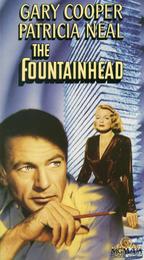 :
Study
Questions: Week One
:
Study
Questions: Week One  :
Study
Questions: Week One
:
Study
Questions: Week One
The Iron Curtain Falls
The Big Lift (1950)
The Fountainhead (1949)
1. What is the significance of the film's title? What is the "fountainhead"?
2. How does Howard Roark's expulsion from architecture school and the fate of his mentor Cameron in the opening sequences of the film set up the film's emphatic message to the audience?
3. In his speech defending his destruction of the housing project he designed, Roark claims that he represents "the individual against the collective" and that the United States is "based on individualism." What does he mean by "individualism"? And, how does his statement parallel a major ideological conflict of the Cold War? Why do you agree or disagree with his argument?
4. If Roark is identified with the United States, what political entity does his antagonist, the architectural critic Ellsworth Toohey, represent? How does his criticism establish that connection? How do the names of the characters reflect the film's attitude toward them (and toward the ideological values they symbolize)?
5. How many pairs of opposing characters (and building designs) exemplify the same Cold War Conflicts? Consider, for example, the contrasts between Wynands and Toohey, Enright the self-made man and the corporate committees deciding on building designs, or the differences between Roark and his rival Peter Keating?
6. How do the settings (offices, homes, public spaces) and the clothes worn by the central characters reinforce the film's political message?
7. In what ways might both the "individualism" depicted in the film and the architectural modernism practiced by Roark be seen as an attack on democracy as well as an attack on socialism? Consider the reason for The Banner's popularity and the style of the buildings which house Wynand's businesses?
8. How does the "individualism" championed by the film tend to reduce all human relationships to exchanges of power. Keep in mind Roark's treatment of potential clients, of his love affair with Dominique Franchon, her marriage to Wynand.
9. Can you describe the characters as human beings who speak and act or as speeches and ideas given human form? What evidence would support your opinion?
10. Why is there a tendency to laugh at shots which the film presents as highly dramatic: i.e. Wynand sitting in his office, Dominique arriving at the quarry in a riding outfit, Roark drilling granite in the quarry, the final shot of Dominique riding the construction elevator to a waiting Roark. How do these scenes undermine the film's political message?
11. What sequences link the film's conception of "individualism" with a patriarchal (perhaps phallocentric is as better word) view of the "healthy" society? Freud once remarked that sometimes a cigar is just a cigar. Can this be said of Roark's jack hammer or his skyscrapers?
12. What is the thematic and the aesthetic significance of the epigraph which introduces The Big Lift? Why are the central characters introduced as they watch a newsreel? To state the question differently, what is the thematic significance of breaking down the difference between a documentary and a fictional film?
13. Why are the American fliers embarrassed being treated as heroes? How does it contrast thematically with the "individualism" exemplified in The Fountainhead?
14. The title of The Big Lift indicates that the Berlin Airlift is the manifest subject of the film? What sequence of events lends the film its narrative structure, that is provides a beginning, a middle, and a conclusion? Dramatically speaking what is the film's climactic moment? Why?
15. Although the film depicts "freedom loving peoples" resisting Soviet aggression, it is equally concerned with the relations between the United States and postwar Germany. How is this relationship embodied in the romantic subplot?
16. In what ways do the attitudes and actions of McCullough and Kowalski symbolize the proper and improper behavior toward a defeated enemy?
17. How do you read the film's conclusion? Is Fredrica a reformed character or a remnant of Germany's Nazi past? In what ways does Gerda reflect the "New Germany"?
18. How is the film's treatment of the reporter engaging in public relations for the military treated? How does the treatment differ from the treatment of media figures in films of the 1980s and 1990s? What doe the contrast say about public attitudes toward the press and toward national institutions like the military?